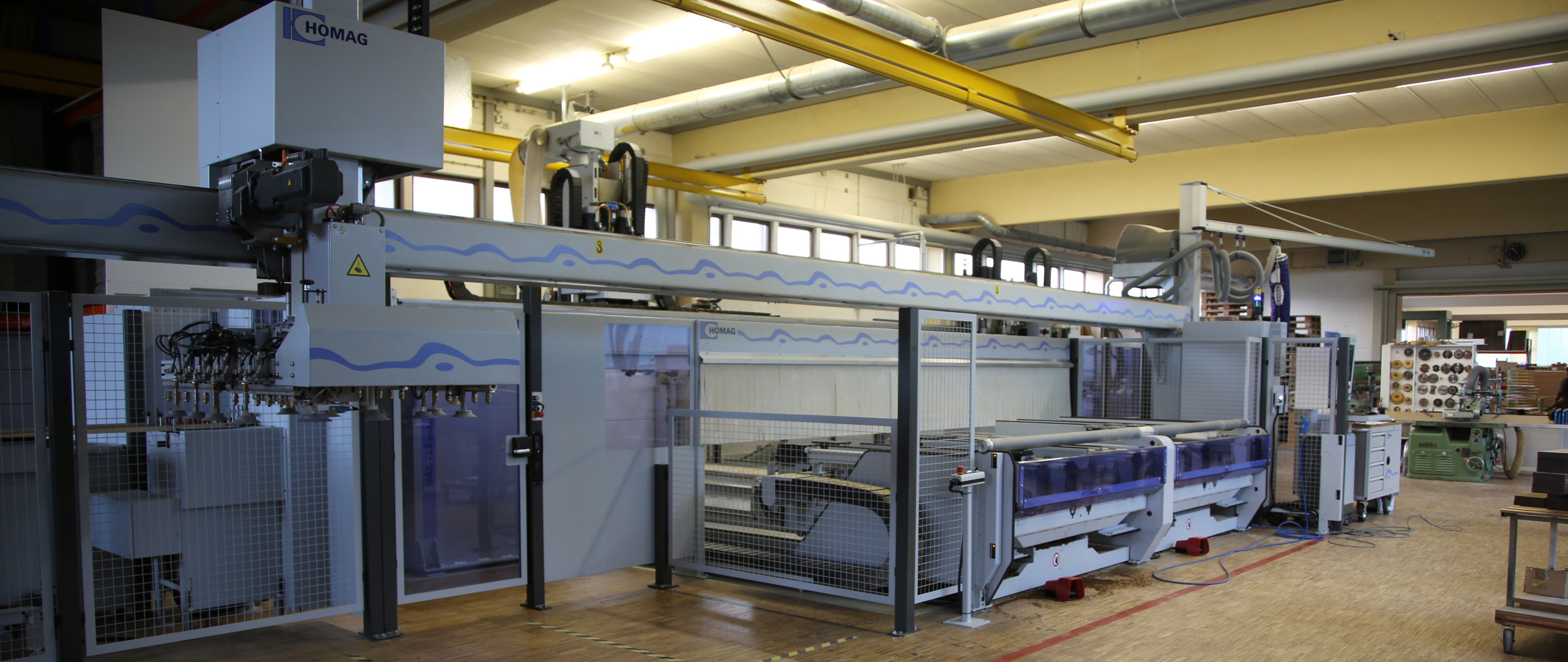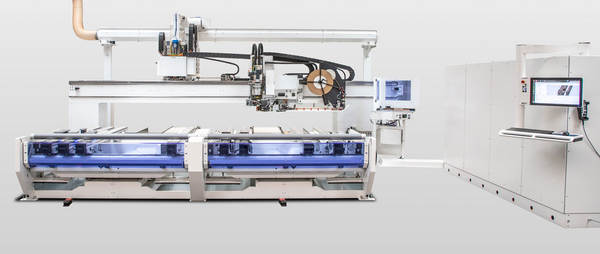
An article from the specialist magazine möbelfertigung, 06/ 2014, www.moebelfertigung.com.
One example involved him taking a fairly unconventional step for a company of this size which - for many - would have involved some sleepless nights. He took the decision to invest in a BAZ 723 gantry processing center from HOMAG, equipped with two independent tables, automatic infeed off the stack, a 5-axis head and edge gluing using the laserTec as well as the hot-melt technique as an alternative..
Bosch and technology from the HOMAG Group: A love story
Since its foundation in 1954 as a locally based building and furniture joiner typical of its time, Bosch had gained a name among its clientele as a producer of top quality hand crafted furniture. Eight years after it was first formed, the first orders began to arrive for fit-outs of commercial buildings such as banks and offices. With this new client base, the need for modern machinery grew. It was 1971 when company founder Bosch saw and fell in love with the first HOMAG edge banding machine – which he lost no time in bringing home to his workshop. This marked the start of an ever closer relationship between Bosch and the technology from Schopfloch. According to Bosch, this close bond was due largely to “quality unmatched by any other competitor”. Over its company history, Bosch has on a number of occasions reaped the benefits of being able to rely fully on HOMAG Group services.
The next purchase came in 1972 with a HOMAG carcase press, which is still doing stalwart service in the hall to this day. Gradually over time, as the demands made by the world of furnishings and fittings changed, so did the machine outfit in Rühlingstetten. Always sensitive to the changing needs of customers and of the industry, the company invested in new technology or replaced obsolete equipment with new innovations. These included additional edge banding machines from HOMAG, a postforming machine from BRANDT, a saw-storage combination from BARGSTEDT and HOLZMA, CNC processing centers from WEEKE (the first in 1992) and HOMAG (the first in 1998) as well as a number of BÜTFERING sanders and a WEEKE CNC drilling and dowel driving machine. Alongside these acquisitions, the company continued to invest in expansion of its workshop, which today covers a production area of 6,000 square meters. Here, a workforce of 31 performs the whole range of batch size one processing operations on furnishing components destined for interior fitting projects, often involving the complete fit-out of offices, banks, shops and hotels across the whole of Europe.
Looking at the demands made on machine technology over recent years, the changes which have taken place have been most noticeable in the CNC sector. There has been a growing demand for the use of processing centers, and the capacity bottlenecks were an increasing problem at the available WEEKE and HOMAG machines. This was becoming a crucial issue for Bosch, which makes short delivery times, high flexibility and absolute adherence to deadlines a particular selling point.
A BAZ 723 to mark a birthday
This prompted the latest and – at first glance – perhaps the most unusual investment for the company to date, marking the next joint step in the HOMAG-Bosch relationship back in 2013. A very special birthday present to mark the company’s 60th Jubilee arrived promptly on schedule in 2014:
A BAZ 723 with two independent tables and one DRIVE5+ 5-axis head. An automatic TBP gantry feeder takes care of feeding and destacking components up to 80 kg in weight. The model also came complete with – in Bosch’s words – the “almost indispensable laserTec method”. This technology is particularly crucial given the company’s aspiration to premium quality in its office furnishing and high-end fit-outs of hotels and prestigious buildings. On the new BAZ 723, around 70% of components are now produced with a zero joint, while conventional methods using hot-melt glue account for the other 30%.
The gantry processing centre with double table offers space for components up to 500 mm in height from the console. It features an integrated double coupled-motion pre-snipping station at the gantry for hot-melt glue edges as well as a triple pre-snipping station at the side for laser edges. Other equipment includes two 18-slot tool changers (one coupled-motion, one fixed at the side), one pick-up slot for the saw, one camera system and one measuring probe for part measurement and processing dimension correction (e.g. in the case of pre-sized components). Bosch uses the DRIVE 5+ 5-axis head predominantly for the positioning axis and miter cuts (Lamello-Clamex connectors).
Singing to a discerning audience
At Norbert Bosch, customer requirements take absolute top priority: “We aim to make our customers happy – without them we are singing to an empty auditorium”. It is not only the latest trends in terms of feel and appearance such as the zero edge that determine how today’s joiners and suppliers operate. Another key driver are the ever more pressing demands in terms of short delivery deadlines and delivery reliability. “If I order a new HOMAG machine today, I can hardly wait until it’s delivered. The same applies to today’s consumers. Nowadays, who has the patience to wait ages for a new piece of furniture?” Using the processing center as an addition to the existing machine outfit, the interior fitting company has made an enormous gain in both flexibility and speed. Both vital factors, because at Bosch things certainly never get boring. Every individual part and every order differs from the next. Added to this, orders frequently come in quite spontaneously.
“As our entire production is batch size one, alternating processing using the two independent tables is a real bonus for us”, explains Bosch. “While we are trimming on one table, gluing can be taking place on the other one.” The combination of different process technologies such as sawing, drilling, edge banding, hardware fitting, measurement operations and 3D processing has made the machine a really future-proof investment for Bosch. “Using the full bandwidth of equipment possibilities, we are able to collate several different work stages. This has increased our speed, allowed us to improve processing precision and at the same time cut handling costs and eliminate the possibility of transport damage.”
Hard worker: No coffee breaks for the processing center
The new processing center has been in operation since February this year. Up until October 31, it had produced 10,000 parts for Bosch – and the tendency is rising. Bosch is now completing a wide-range of operations on the new center which it had never originally envisaged. For example it is used to make simple grooving cuts which are otherwise performed on a throughfeed machine. Performing these cuts on the BAZ 723 does not tie up any operators: The stack is simply placed ready and the feeder positions one workpiece at a time on the table. The double table arrangement means that the feeder is constantly in motion, and the parts are finish processed within a minimum of time – and the machine will happily go on working for a few hours after the end of a shift. While the staff leave to enjoy a well-deserved evening’s relaxation, the HOMAG continues to beaver away in the workshop. A smart touch: Bosch is able to keep an eye on the lights of the BAZ 723 from his living room, and from the comfort of his sofa is able to see if the machine is still busy working or if a problem could have occurred. “This is a pretty rare occurrence”, said Bosch. “During the month of October, our availability reached exactly 100%”.
A good nose …
…for upcoming trends is something Bosch has developed over the years. The furniture business is constantly on the move, with customers developing new tastes and ideas – but Bosch is usually a few steps ahead of the game. Once customers realize what it is they need, Bosch is generally able to produce with the promise of minimal delivery periods. Since the new processing centre has been in operation, he has already succeeded in landing five new clients, including a trade fair stand construction company, a planning office for complex projects and private investors. Bosch is currently fitting out a newly constructed student residence in Frankfurt’s banking quarter with 400 rooms. This is set to be followed by a student residence in Munich with 1000 rooms.
Four hours from order placement to delivery
Its new acquisition allows Bosch GmbH to now produce supply components within just four hours of placement of order. Not only are the parts finished in record time, they are also produced to an exemplary standard of quality.
“It is not uncommon for an order to land in the inbox at midday, and the finished product to be on its way out of our dispatch department by 4.00 p.m. During this period, we are able to produce up to 20 parts per order. On average, our delivery period for finished parts is six working days. We are extremely flexible, which is something none of my competitors can claim. But all this would not be possible without the right employees. And I have a great team on board.” This degree of speed and flexibility does not require planning weeks in advance. “Our planning horizon is the next three weeks maximum – we have never looked further ahead than that”, says Bosch. And the concept seems to be working: After all, quick decisions are his forté.

